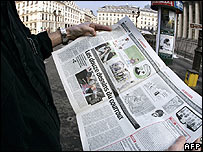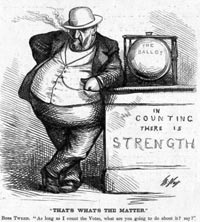| (insert your NIE or newspaper logo here) |
Weekly Online LessonOnline Lesson ArchiveGrade Level: 8-12
|
Editorial Cartoons Spark Outrage
 A
dozen cartoons published by one of Denmark's leading newspapers, Jyllands-Posten,
in September 2005—and re-printed in more than 60 other newspapers
since then—have sparked anger and violence among many Muslims
worldwide.
A
dozen cartoons published by one of Denmark's leading newspapers, Jyllands-Posten,
in September 2005—and re-printed in more than 60 other newspapers
since then—have sparked anger and violence among many Muslims
worldwide.
The variety of editorial, some say satirical, cartoons depict Islam's Prophet Muhammad. These are offensive to many Muslims, because Islamic tradition explicitly prohibits images of Allah, Muhammad and all the major figures of the Christian and Jewish traditions.
So why did the Danish newspaper publish them, knowing that it would likely stir up social unrest? It was a test, Jyllands-Posten explains, of whether the integration of Muslim fundamentalists into Danish communities had begun curbing the freedom of expression there.
Opinions outside of that newsroom vary widely. For example, some people believe that the cartoons have served only to stoke social tensions, while some others believe that they have helped open a difficult but necessary conversation on an important topic.
For years, editorial cartoons have been used to state opinions about social, economic, or political issues—with mixed agreement. Common among all of them is their use of symbols or situations that are familiar to us, which offer insights into our local, national, and internatonal cultures.
You'll start this week's lesson with the history of political cartooning in the United States. Then you'll visit with a accomplished cartoonists, as they explain how and why they create their own editorials.
Political Cartooning in America
 Begin
your toon training with American
Political Cartooning at Truman State University.
Begin
your toon training with American
Political Cartooning at Truman State University.
Read the introduction, and then find out about The Rise to Fame.
Why was Tweed more upset over the cartoons than with the newspaper articles? How would you describe Tweed, based on Nast's caricature of him? Why did the cartoons help boost newspaper sales?
Do you think that Nast followed The Ethics of Cartooning? Is editorial cartooning art or journalism? In what ways do cartoons compare with the printed word and why?
Next, learn more about cartooning's Elements of Effectiveness.
Write down the four basic elements of good political cartoons for later reference. What are some symbols used by earlier cartoonists that are still familiar today?
Artists also used Composite Portraits, which represented groups of people who were not white, property-owning, men. In what ways did cartooning boost the women's suffrage movement?
Cartooning Careers
 Now,
let's examine the life and work of several famous political cartoonists,
starting with Herblock's
History: Political Cartoons from the Crash to the Millennium.
Now,
let's examine the life and work of several famous political cartoonists,
starting with Herblock's
History: Political Cartoons from the Crash to the Millennium.
Read the Introduction to Herb Block's life, and then let him share with you his viewpoint on The Cartoon.
According to Herb Block, what role do political cartoonists play in our society? What are the different types of relationships a cartoonist can have with the rest of the newspaper in which the artist's work is published? In what ways do other people's opinions and expertise help create the sharpest cartoon?
To see how Block's talents and viewpoints have played out over his career, browse through some of his cartoons by category (click on each cartoon title or thumbnail for larger view):
- Presidents
- More Light!
- Another Dove
- Tick-Tock
- Fire!
- Fruits of Victory
- Animal Farm
- Ascent Into the Unknown
- I Am Not a Crook
- One Nation, Indivisible
- Corporate Body Snatchers
- Sorcerer's Apprentice
- Lines in the Sand
- Hare and Tortoise
What kinds of historical events influenced Block's cartoons? What key figures or symbolic representations did you recognize? Which featured topics and issues are still being debated today?
 Next,
let's visit the Newseum to get familiar with three more editorial cartoonists: Ann
Telnaes, David
Horsey, and Joel
Pett.
Next,
let's visit the Newseum to get familiar with three more editorial cartoonists: Ann
Telnaes, David
Horsey, and Joel
Pett.
Explore the cartoons and commentary of each artist. As you review them, keep in mind the four basic elements of good political cartoons that you wrote down earlier.
Is the general artistry of good quality? Did each cartoon express genuine sentiment? Did each include fresh, uncomplicated imagery? Did the cartoon highlight a topic of lasting importance and recognition?
What symbols do you see in the cartoons? Why do you think these symbols were chosen, and what do they represent? In what ways does each cartoon not only represent a topic, but also the context of our social culture at the time?
Newspaper Activities
Read news stories in Targetnewspaper, and identify one issue that you feel you have a strong opinion about. Learn as much as you can about your topic by carefully reading the newspaper reporters' on-going articles about it and by doing additional research, if desired. Organize your thoughts by summarizing the topic in one sentence, identifying key players (individuals, nations, other groups, etc.), stating your opinion about it in one sentence, and listing the reasons for your opinion. From there, brainstorm familiar pop-culture representations, comparisons, etc. that could be used to illustrate your viewpoint, keeping in mind the four basic elements of good political cartoons. Sketch out two or three ideas on paper. Then, share them with your friends or classmates, asking them for constructive feedback about which one might best represent the issue and your opinion about it. Use their comments to refine your "best" cartoon. You may wish to draw and color your polished cartoon by hand, or you can use clip-art and a computer program to create it. As a class, post your editorial cartoon gallery in a school hallway. What are people's reactions to the cartoons?
© Copyright 2006
Learners Online, Inc.
